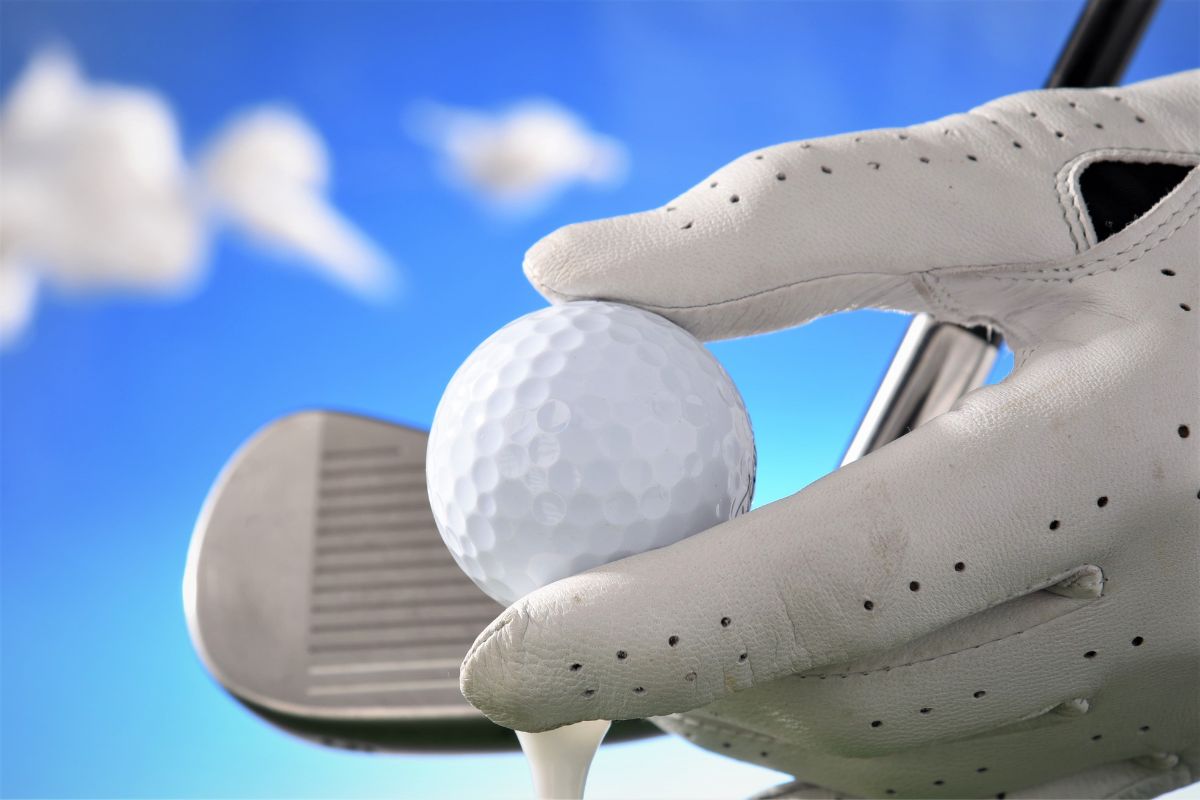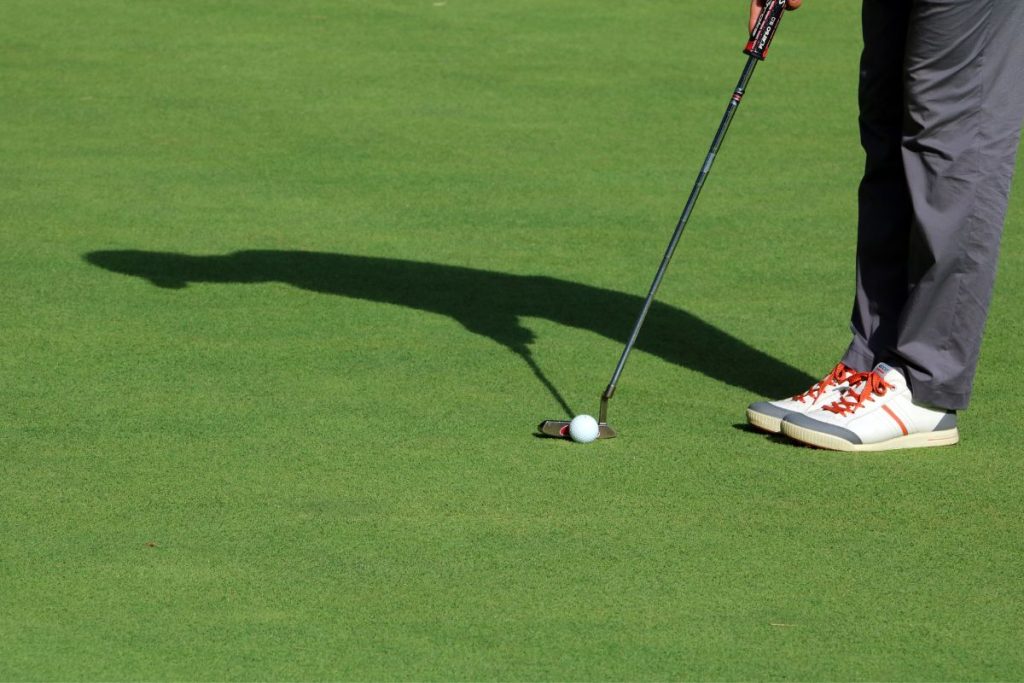When you compress a golf ball, it refers to when you strike the ball in such a manner that the gap between the loft of the club and the attack angle is reduced.
Essentially, you’re attempting to hit the ball with a delofted clubface and a shallow angle of attack in order to make a more solid impact and transmit more energy from the club to the ball.

You might have struck an iron shot that felt a little odd in your hands now and again.
If it seemed pure and exquisite, as if the golf ball was pressing against the clubface before launching into the distance, you probably compressed the ball rather nicely.
Compressing the golf ball with your irons improves both the accuracy and distance of your shots.
It allows the ball to receive the most force from the club while avoiding scooping the ball, which creates those weaker, iron shots that also tend to be higher than you want them to be.
If you are curious as to how to compress the golf ball, then keep reading.
Golf Ball Compression
A golf ball’s compression relates to how tightly packed its core threads are. The harder or more squeezed the core is, the tighter they are coiled.
Golf balls (see also: What Is Ball Ammo?)are available in a variety of compression rates, with the lower number indicating less compression.
A low compression ball is coiled less tightly and is considered softer. A ball with a higher compression is wrapped tighter and considered tougher.
Players with slower swing speeds (usually beginners, juniors, seniors, and women) favor lower compression balls because they give greater distance.
Most advanced players like medium compression balls because they can achieve better (but not necessarily maximal) club speed (see also: What Is A Smash Factor?)and desire excellent control to go with their power or distance.
Higher compression balls demand a quicker swing speed to attain maximum distance but give a more consistent flight and are hence chosen by more powerful hitters.
Low Compression
Because of its softness and response to a swung club, low compression balls are ones that have a rating of 80 or below and move farther than more tightly wound balls.
Low compression balls do not fly as straight compared to harder golf (see also: How To Hit A Golf Ball Straight)balls and will be more difficult to manage because they are softer.
Medium Compression
For the best mix of control and distance, then you should use a medium compression golf ball which has a rating of 90.
High Compression
High compression balls have a compression value of 100 or greater and are utilized by the toughest hitters, who frequently require the maximum precision they give.
How to Compress the Golf Ball
Here are the main steps that you should take to compress the golf ball.
Keep Your Weight Forward
You should put greater emphasis on your lead side when it comes to your weight distribution. That is your left leg for righties and your right leg for lefties.
Ballard recommends putting 60-70 percent of your weight on this side to get your hands ahead of the ball.
The goal is also to keep you from leaning back into contact, which increases clubface loft and balloons your strikes.
Face Your Right Palm Downwards
When it’s time to strike the ball, make sure your right palm is facing downwards toward the ground.
This will help in squaring the face and stopping the blocked shot, and will also prevent the ball from being scooped up in the air rather than sending the greatest energy into the rear of the ball for a ball compression.
Maintain Speed
To get the perfect impact, the highest handicap golfer may strive to slow down their swing through impact. The ideal impact is the product of appropriate motions and cannot be forced.
Getting the ideal body movement, wrist motions, and thoughts of focusing on the target can help you release properly, putting you in a solid impact position.
This all starts with maintaining your pace through the striking zone without becoming jerky or leaping too forcefully.
Many golfers find that when they stop attempting to control every part of their swing and instead focus on the goal with a simple notion like utilizing the back of their left hand or the palm of their right hand, they get the outcomes they want and the compression that feels fantastic.
Hit Down

While striking down on a golf ball does not produce compression, your angle of attack with irons should be 3-4 degrees lower.
This allows you to go down and through the ball while keeping your angles. It aids in reducing club loft and producing a ball flight that is excellent for your irons.
When some golfers begin to swing up at a golf shot, they frequently flip the right hand during the stroke, adding loft and decreasing compression.
Instead, hit the shot down and through with the feeling of a smack in the back of your left hand and wrist.
Rotate Your Hips
For a better loft and a more potent blow, your hips should expand at a 45 degree angle to the target during contact.
Unfortunately, the average amateur can only generate a hip turn of 30 degrees, indicating that the majority are not generating adequate compression.
In order to reach the objective, you must also extend your shoulders and rib cage.
Many amateur players hit the ball with their hips and shoulders square to the impact zone and fail to maximize rotation through contact.
If you’re fortunate enough to strike the ball cleanly, you’ll notice that this makes you stand up straight upon contact and increases your clubface loft, which might result in a skied stroke.
At impact, you may generate a well-hit shot and assure a reduced spin loft for a controlled launch and a lot of distance by clearing your hips.
The ability to bring the clubface square upon contact for better accuracy is also enhanced by opening your hips, shoulders, and rib cage to the target.
Summary
Now that you know what it means to compress a ball and how you do it, all that is left to do is apply what was stated in this guide and practice, practice, practice!
- Can You Bring Your Own Clubs To Topgolf? - November 15, 2022
- How Wide Is A Golf Cart? - November 15, 2022
- How Long Does 9 Holes Of Golf Take? - November 15, 2022
